Understand why graffiti is a social issue, considering both its artistic merit and the disruption it causes. Find out how communities are addressing the impact of graffiti.
Vandalism vs. Art: The Ongoing Debate
The debate between graffiti and vandalism versus street art continues to be a divisive social issue. While some view graffiti as urban art that conveys political messages or personal expression, others see it as an act of defacement contributing to urban decay. Public perception of graffiti often depends on its context—a mural commissioned on a wall may be celebrated as art, while tags on public property are typically classified as graffiti and vandalism.
This conflict highlights the social impact of graffiti. It blurs the line between creative expression and criminal activity. Advocates of street art argue that graffiti can beautify neglected spaces and foster cultural conversations. Critics, however, contend that unauthorised graffiti can harm property values and create a sense of lawlessness. Understanding graffiti as a social issue requires balancing its artistic merit with the need for public order.

Impact of Graffiti on Communities
The impact of graffiti on communities is significant, influencing both aesthetics and safety perceptions. Graffiti and urban decay are often linked, as areas with visible graffiti may be perceived as neglected or unsafe. This can lead to reduced community pride and deter investment, further exacerbating social and economic challenges.
Graffiti as a social issue also affects how residents interact with their environment. While some forms of street art can inspire dialogue and reflect local culture, unauthorised graffiti is often seen as intrusive and disruptive. The presence of graffiti can correlate with higher crime rates, as it may signal a lack of enforcement or community oversight.
However, not all graffiti has a negative impact. In some cases, it serves as a form of grassroots activism, highlighting social or political issues. Communities addressing the social impact of graffiti often find that involving local artists in creating legal graffiti spaces can reduce vandalism and foster a sense of ownership.
The Economic Costs of Graffiti Removal
The economic cost of graffiti is a major concern for cities and property owners. Graffiti removal costs can run into millions annually, placing a significant burden on local governments and taxpayers. Public services must allocate resources for cleaning affected areas, diverting funds from other community improvements.
For businesses, the economic cost of graffiti includes both direct expenses, such as removal, and indirect losses due to reduced foot traffic or perceived decline in safety. Properties with recurring graffiti issues may see a drop in market value, further impacting local economies.
Despite these costs, solutions for graffiti problems often include investing in prevention measures such as surveillance systems, anti-graffiti coatings, and community engagement initiatives. Cities that adopt proactive approaches, such as legal graffiti spaces and youth outreach programmes, can mitigate the financial burden while addressing the root causes of graffiti as a social issue.

Legal and Ethical Considerations
Graffiti raises complex legal and ethical questions. Legal issues with graffiti centre on property rights and the unauthorised nature of most graffiti. Laws against graffiti often carry penalties ranging from fines to imprisonment, reflecting the seriousness with which it is treated as a form of vandalism.
Ethically, the debate revolves around whether graffiti should be considered a valid form of expression or a violation of public and private spaces. Advocates argue that graffiti as urban art allows marginalised voices to be heard, addressing societal issues that may otherwise go unnoticed. Critics, however, highlight the ethical implications of damaging property and the economic strain it places on communities.
The Role of Graffiti in Youth Culture
Youth culture and graffiti are deeply intertwined, with graffiti often serving as a means of self-expression for younger generations. For many, creating graffiti is a way to establish identity, challenge authority, or convey political messages. This connection underscores graffiti’s role in addressing broader social issues, from inequality to urban neglect.
However, the association between youth culture and graffiti as a social issue also raises concerns. Young people engaging in unauthorised graffiti may face legal consequences, which can have long-term impacts on their lives. Additionally, graffiti and crime rates are often linked, creating a stigma around youth involvement in street art.
To address these challenges, many communities focus on providing alternatives such as legal graffiti spaces and art programmes. These initiatives channel youthful energy into constructive activities while reducing vandalism. Recognising the role of graffiti in youth culture is key to finding solutions that balance creative expression with community needs.
Ripon Exterior Cleaning offer graffiti removal in Stockton-on-Tees and the surrounding areas. We perform our graffiti removal services with the highest attention and efficiency.


